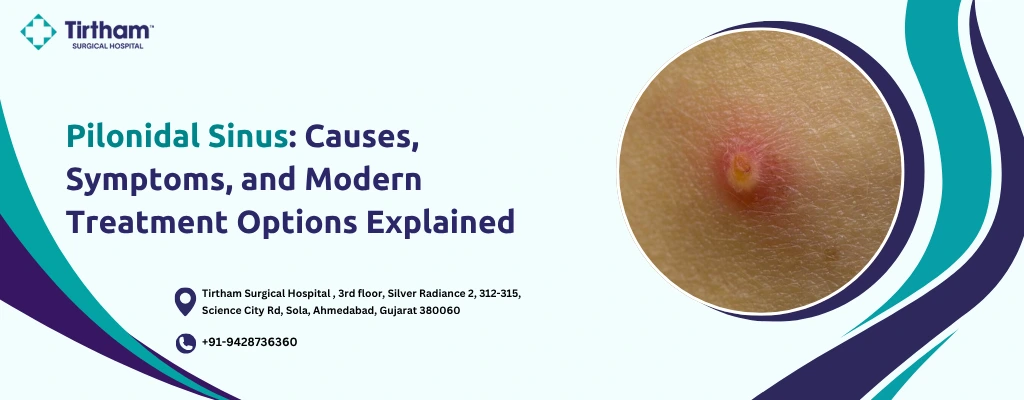Pilonidal sinus is a small hole in the skin, usually near the tailbone, that can fill with pus or hair. If you do not get proper treatment you will get pain, infection and swelling in the lower back near the tailbone. If you have a pain or swelling in the lower part near the tailbone, it might be pilonidal sinus. Lets understand the pilonidal sinus causes, symptoms, and the latest treatment options available.
Whether you’re seeking Pilonidal Sinus Treatment in Ahmedabad or simply want to learn more about it, this blog will walk you through everything you need to know.
What is a Pilonidal Sinus?
A pilonidal sinus is a small tunnel or tract that forms under the skin, typically near the top of the buttocks, where hair and skin debris collect. Over time, this can become infected and fill with pus, forming an abscess.
This condition is more common in men than women and tends to affect people between puberty and age 40. Sedentary lifestyles, poor hygiene, and excessive body hair increase the risk.
What Causes Pilonidal Sinus?
There are multiple factors believed to contribute to the development of pilonidal sinus. Some of the most common include:
- Ingrown Hair: The most accepted theory is that loose hair penetrates the skin, triggering an immune response that causes a cyst to form.
- Friction and Pressure: Prolonged sitting or repeated trauma to the sacrococcygeal area can increase the risk.
- Hormonal Changes: The condition often appears after puberty, suggesting a link to hormonal activity.
- Family History: Some people may have a genetic predisposition due to body structure or hair type.
If you’ve ever wondered what causes pilonidal sinus, it’s a combination of these anatomical and lifestyle factors.
Symptoms of Pilonidal Sinus
Recognizing the symptoms of pilonidal sinus early is important to avoid complications like infection or recurrence. Common signs include:
- Pain or tenderness near the tailbone
- Swelling or a lump that may leak pus or blood
- Redness and warmth in the area
- Foul odor due to drainage
- Fever (in case of severe infection)
If you experience any of these symptoms, it’s crucial to consult a specialist as soon as possible to evaluate your condition and prevent further complications
Pilonidal Sinus Treatment Options
Fortunately, modern medicine offers a range of pilonidal sinus treatment options, from conservative management to advanced surgical techniques.
1. Conservative Treatment
In mild cases, especially when there’s no infection, doctors may recommend:
- Warm compresses
- Good hygiene practices
- Hair removal (laser or shaving)
- Antibiotics (for minor infections)
However, conservative methods do not remove the sinus tract and are often temporary solutions.
2. Surgical Options
Surgery is usually the most effective long-term solution. These may include:
- Incision and Drainage (I&D): A minor procedure to relieve pain by draining the pus. It does not cure the sinus itself.
- Excision Surgery: The sinus tract is surgically removed. Healing may be slow but offers a high success rate.
- Laser Pilonidoplasty: A minimally invasive and advanced technique. It involves using a laser to ablate the sinus tract. Patients experience less pain and quicker recovery.
If you’re looking for Pilonidal Sinus Treatment in Ahmedabad, many hospitals now offer advanced laser treatments that are safe, effective, and require minimal downtime.
Choosing the Right Hospital for Treatment
Selecting the right facility is crucial for successful treatment. If you’re in Gujarat, you may want to consider the Best General Surgical Hospital in Ahmedabad. Look for hospitals that offer:
- Experienced general and colorectal surgeons
- Modern laser and minimally invasive technology
- Clean surgical environments to reduce recurrence risk
- Personalized aftercare plans
The right hospital can significantly reduce complications and help ensure long-term recovery.
Recovery and Aftercare Tips
Post-surgical care plays a huge role in preventing recurrence. Some essential tips include:
- Maintain personal hygiene in the affected area
- Avoid prolonged sitting
- Wear breathable, loose-fitting clothes
- Follow your doctor’s wound care instructions
- Consider permanent hair removal for high-risk areas
By following these tips, many patients can return to normal life within days or weeks, depending on the treatment type.
Conclusion
Pilonidal sinus is a treatable condition, especially when diagnosed early and managed with the right care. From understanding what causes pilonidal sinus to recognizing the symptoms of pilonidal sinus and exploring the latest pilonidal sinus treatment options, patients have more choices and better outcomes than ever before.
If you’re considering Pilonidal Sinus Treatment in Ahmedabad, consult with the Best General Surgical Hospital in Ahmedabad to receive expert advice and modern care. Don’t let this condition affect your quality of life-early diagnosis and appropriate treatment can make all the difference.




